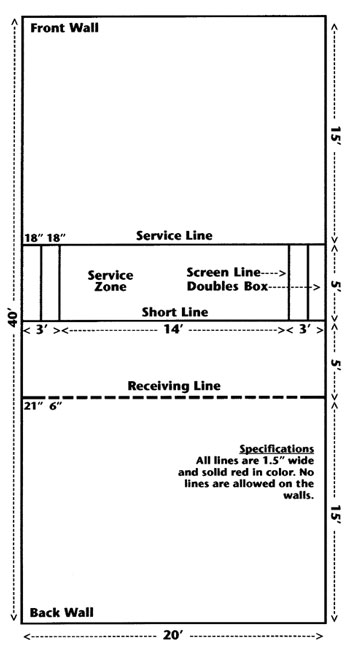Advanced Racquetball Rules
Everything I’ve covered in the Basic Racquetball Rules should provide you enough information to get a functional game going, if both players are beginners and just need to understand enough of the main points to start playing. However, there are still quite a lot of “edge case” scenarios that you need to understand to play a proper game of racquetball. Here’s a list of fairly common situations that you should know how to handle.

During serves:
- if the ball lands before the short line, it’s called a short serve and it’s a fault.
- if the ball hits the back wall before hitting the floor, it’s called a long serve and it’s a fault.
- if the ball, after rebounding off the front wall, passes so closely server that the receiver doesn’t have a clear view, it’s called a screen serve and it’s a fault.
- if the ball, after hitting the front wall, hits 2 side walls before hitting the floor, it’s called a three-wall serve and it’s a fault (typically happens with Z serves).
- if the ball does not touch the front wall first, it’s an immediate out.
- if the ball, after hitting the front wall, hits any part of the server or the server’s racquet, it’s an immediate out.
When receiving:
it’s not allowed to cross the receiving line either with racquet or body until the ball either crosses the receiving line or bounces in the safety zone and when that happens, a point is awarded to the server.
Hinders:
- in a tournament game with a referee, there’s a difference between a replay hinder and a penalty hinder and the referee makes that judgement call. But in majority of friendly games it is generally agreed that hinders cause a simple replay.
- if the ball hits the body of the opponent, it’s a replay hinder except when it was obvious that due to the velocity the ball would never have reached the front wall any way. In that case, the player who hit the ball loses the rally.
- a player who is returning the ball and realizes there’s a possibility of hitting the opponent either with the racquet or the ball can (and should) stop the action and call a hinder. This is supposed to be a fun game and safety comes first, so there’s absolutely no reason to put your opponent in any sort of risk of a body harm.
- it is the responsibility of the players to make reasonable attempts to move out of the way to provide the opponents enough room to safely swing the racquet and have a clear shot at the front wall. Due to the nature of the game, it’s not always possible, and hinders will happen. And that’s ok. The important thing, once again, is to play it safe and have fun, so it’s always better to just call a hinder and replay a rally, if there’s a possibility of someone getting hurt.
I did not cover every single rule because if I were to do that, this article would be a dozen pages long and I would simply be copying the official rules. But if you are interested in reading the official USA Racquetball rules, you can download the PDF directly from USAR site.
